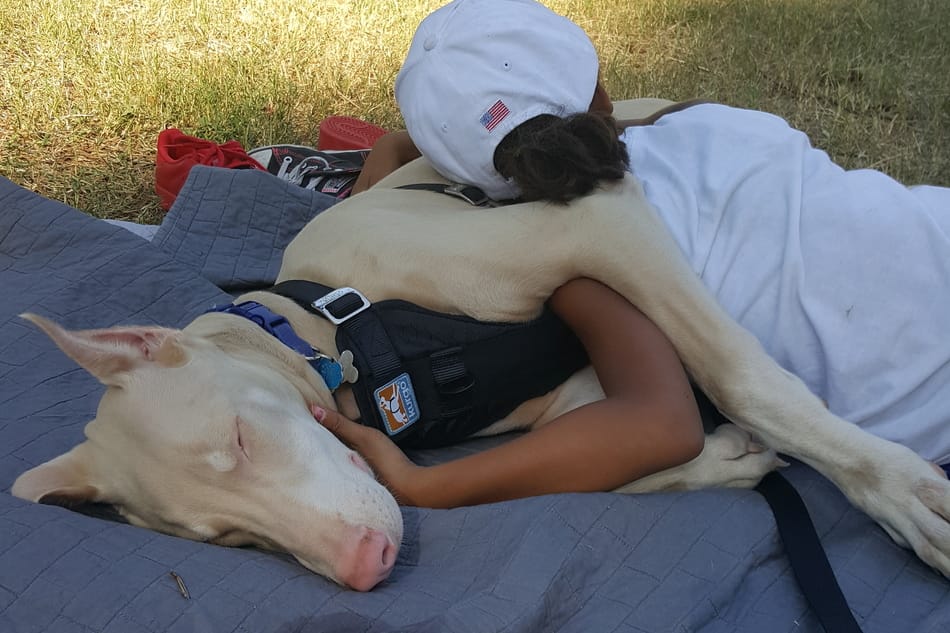
Many people new to Dobermans don’t know that the white (or cream-colored) Doberman even exists and are often surprised, or even confused, as to what breed the dog is when they first see one. These dogs are also often referred to as “albino Dobermans”, although they aren’t truly full albino in the classic sense of the word, you can see how someone new to them might think that’s the case due to their very light coloring.
The white Doberman is surrounded in controversy as many believe it’s unethical to breed this color of Doberman for health reasons, including the DPCA (Doberman Pinscher Club of America). So I decided it was time to dive head-long into this topic by reviewing the latest research and information about the white Doberman. Here you’ll find information about their albino status, history, genetics, health concerns, life expectancy, costs, and much more.
Table of Contents
Albino vs. White Dobermans
First, we need to discuss what these dogs actually are, and aren’t. Even whether or not these dogs are albinos is currently hotly debated by professionals. But here is what we know so far.
White Dobermans are actually a light cream color with white-colored markings. They also have a pink nose, lips, rims of the eyes, and blue colored eyes. These dogs are not albinos in the traditional sense of the word as they still have some pigmentation (for example, blue eyes are only possible with some pigmentation, a complete lack of pigment would make eyes that appear pink in color). It’s widely agreed upon that white Dobermans are technically “tyrosinase-positive Albinoids” (source). Sure, this is a type of albinism, but not the traditional albino that you or I might think of.
If you refer to these dogs as simply “albino” you may get some looks from those who are well versed in the Doberman world. Simply because many Doberman professionals will believe that you’re referring to the traditional full-albino, which these dogs aren’t. So, if you want to be accurate you could refer to them as “tyrosinase-positive albinoids”, but it’s probably easier to just refer to them as “white Dobermans” or “cream Dobermans.” For the sake of this article, I will be referring to them as white Dobermans.
It is genetically possible for there to be full-albino Doberman due to the occurrence of the traditional genetic mutation that causes albinos in the animal world, but so far a true “full-albino” Doberman is not known to exist. You can tell the difference because a true full albino Doberman would have pink eyes due to the complete absence of pigment. Whereas a white Doberman will have blue eyes (i.e. some pigment is present).
History
The first white Doberman registered with the American Kennel Club (AKC) was named Padula’s Queen Sheba (aka “Sheba”). She was both on November 10, 1976, to two black and rust-colored parents. Interestingly, her pedigree has the words “first white Doberman not put to sleep” written on it. This implies that there were other white Dobermans born before her. Although this remains a mystery, there is some literature as far back as at least the 1930s that refers to a “light-colored Doberman.”
There were initially many doubts as to whether Sheba was a purebred Doberman Pinscher. But, in 1978, Padula’s Queen Sheba was successfully registered with the AKC after the owner was able to provide sufficient proof to the organization that she was, in fact, a purebred Doberman Pinscher.
Sheba was later bred with her son and the son was bred with his sisters all in an attempt to secure this genetic trait. Since then, all known white colored Doberman Pinschers have descended from Sheba.
NOTE
An interesting first-hand account of how the white Doberman first became known to exist to the DPCA is available on the DPCA Albino Doberman History Page.
Genetics
All coat colors in dogs come from a mixture of black pigment (Eumelanin) and red pigment (Phaeomelanin). The genetics of each individual dog will determine how much of each pigment is present in their coat, and how diluted each pigment is. This creates all the coat colors that we are used to seeing in the Doberman Pinscher such as black, red, blue, and fawn (Isabella).
It’s now known that the white Doberman is the result of a different recessive gene that actually masks the final color that would have otherwise been produced by the normal genetic process (source). This gene is a mutated copy of the SLC45A2 gene. This gene is missing a large portion of its typical genetic code (source). The result is something that is somewhat typical of a form of albinism but the proper term for this is currently unknown. This same mutation is known to cause OCA4 (or Oculocutaneous Albinism Type 4) in other animals.
If a Doberman has one copy of this mutant gene, they are considered to be a “carrier” and if they have two copies, they are considered to be affected by this mutation and will appear as a white (or cream) color. In other words, two copies of this mutated gene are necessary to make this color of Doberman possible.
To see how to easily check your Doberman for this mutant gene at home with a simple to use kit, take a look at my Doberman DNA Health Testing Guide here.
This means that breeding two carriers of this genetic mutation in the SLC45A2 gene will produce 25% white (or cream) colored offspring (source).
Researchers believe that this gene mutation occurred five generations before Sheba (at a minimum) since both of her parents had to be carriers for her to be born. They likely inherited this from a common ancestor.
Puppy Prices
Just like with anything for sale in a free market, it’s price has less to do with what these dogs “should be” sold for and more to do with what price the breeder believes they can get for the dogs. For this reason, you’re likely to see a broad range of prices for these dogs.
In preparation for this article, I reached out to multiple owners of white Dobermans and a few breeders. I collected the data on the typical prices for these dogs and here’s what I discovered.
| White Doberman Puppy Prices | |
|---|---|
| Minimum Price | $800 |
| Maximum Price | $2500 |
| Average Price | $1600 |
Note: This is an example of prices owners have actually paid for the white Dobermans. These amounts are rounded to the nearest hundred dollars.
It’s important to remember that many other factors can affect the price of a white Doberman puppy as well, including location, titles earned, kennel club registration status, if the ears are cropped, etc.

There are many out there who strongly believe that these puppies shouldn’t cost any more than your typical Doberman. However, many breeders will still advertise these dogs as rare and use that to justify a higher price for them. While they are certainly less common than other colors, there are many breeders that specialize in these “alternative colors” and a determined buyer can find multiple sources for one of these dogs with enough effort.
Health Concerns
There are some additional health concerns when it comes to white Dobermans. Due to their reduced levels of pigment, some issues can arise, including:
- Sun Burn– White Dobermans are prone to sunburn because of their reduced pigment. This means dog-friendly sunblock may be necessary for prolonged exposure to the direct sun (especially on the nose). Clothes may also be appropriate, or simply just limiting time outdoors in the sun.
- Tumors – One study showed a significant increase in skin tumors with white Doberman pinschers as compared to the standard colors. Specifically, 12 in 20 White Dobermans in the study had tumors present while only 1 in 20 of the standard color Dobermans did (source). Interestingly, in this study, every white Doberman over the age of 5 had at least one tumor. It’s worth noting that while the majority of these types of tumors are likely to be cancerous, they can also be benign.
- Vision – The lack of pigment present in the iris of the white Doberman’s eyes (the colored portion of the eye) means more light can pass through directly to their retina. This causes the dog to often squint in bright light. Some owners choose to buy dog-specific tinted goggles for their dogs while others state this is not necessary.
- Other Concerns – Additionally, white Dobermans are prone to the same health issues that any other Doberman is prone to. This includes gastric dilatation and volvulus syndrome (GDV or bloat), hip dysplasia, dilated cardiomyopathy (DCM), chronic active hepatitis (CAH), von Willebrand’s Disease (vWD), cervical vertebral instability (Wobbler Syndrome), progressive retinal atrophy (PRA), hypothyroidism, and osteosarcoma (bone cancer). See more about the health concerns of Dobermans here.
In general, there is likely to be a bit higher commitment of the time and attention required of the owners of white Dobermans. Factors such as time in the direct sun, sunscreen, and other concerns may need to be considered.
The best way to get an understanding of your dog’s overall health, is to get them DNA health tested. Nowadays this is a simply process that you can do yourself and find out what you can expect from your dog down the road when it comes to health. I hate just watching the years tick by and not knowing what’s coming.
For an idea on how to do this DNA health testing yourself, check out my guide on health testing your Doberman here.
Inbreeding
There are major concerns in regards to inbreeding occurring within the white Doberman’s lineage. It’s well documented that the first registered white Doberman with the American Kennel Club (AKC) was later bred to her son and her son was bred to his sisters. Also, all known white Dobermans are believed to be descendants of these first few.
However, the major concerns aren’t always with this initial breeding which started off the white Doberman. Many are concerned with the potential inbreeding that may be occurring in more recent generations. While I will touch more on this in the “controversy” section of this article, it’s theorized that extensive inbreeding occurs by unethical breeders hoping to produce more white-colored Dobermans. Although this is likely the case in some circumstances, there are also unethical backyard breeders who inbreed standard colored Dobermans for other reasons as well (or who simply unknowingly inbreed due to lack of research on lineage).

Life Expectancy
10 – 13 Years
To date, there have been no studies or large data collection efforts that provide insight into the longevity of the white Doberman as compared to other Doberman colors. The closest we have currently on this topic is the study titled, “A Partial Gene Deletion of SLC45A2 Causes Oculocutaneous Albinism in Doberman Pinscher Dogs” (available here) which does indicate a higher prevalence on potentially cancerous skin tumours on the white Dobermans (12 in 20 white Dobermans had these tumors while only 1 in 20 of the standard color Dobermans did). It’s worth pointing out that the sample size of 20 Dobermans is very small.
Since no studies have directly shown a higher mortality rate or shorter lifespan, the current life expectancy for the white Doberman will remain at 10 to 13 years—or the same as the standard color Dobermans.
TIP: For a catalog of all the available Doberman colors and types, see my article All the Colors and Types of the Doberman Pinscher.
DPCA and White Dobermans
The Doberman Pinscher Club of America (DPCA) is a member club of the American Kennel Club (AKC). It is the AKC’s one and only Doberman specific club. The DPCA has made it clear that it does not condone the continued breeding of white Dobermans. It states that due to their health issues and photosensitivity (or photophobia), the dog is considered an “unacceptable specimen” and since their mission is to protect the integrity, health, and function of the breed, they will not promote their breeding (source).
In 1982, the DPCA amended its breed standard for the Doberman Pinscher to allow only four colors. These are black, red, blue, and fawn Dobermans with rust-colored markings. The breed standard states, “White patch on chest, not exceeding 1/2 square inch, permissible. Disqualifying Fault: Dogs not of an allowed color.” The complete breed standard can be found here.
This means that if a dog has any more white than just a half square inch on their chest, the dog is disqualified from breed conformation shows. It also states specifically that dogs that are not of an allowed color are disqualified. This means the white Doberman would be ineligible to participate in breed conformation shows. However, the white Doberman can still compete in every other companion event including obedience, agility, rally, and tracking.
The DPCA’s official stance is that these dogs should not be bred and that breeders should ensure they aren’t mating pairs of dogs who have this in their pedigree. Puppies from parents who are either carriers or who are dogs in the known lineage which has had white puppies in the past will be notated with a “WZ” before their AKC registration number. This is unofficially referred to as the “Z-List”.
All the DPCA materials in regards to the white Doberman can be found on the DPCA Albino Reports page here.
White European Dobermans
The FCI (Federation Cynologique Internationale) is a worldwide kennel club that is well known and deals extensively with European Dobermans. This organization does not recognize white as an accepted color in their breed standard. In fact, any white fur on a Doberman is a disqualifier with the FCI.
The Doberman breed standard for the FCI states, “The Dobermann is bred in two colour varieties: black or brown with rust red, clearly defined and clear markings (tan markings).” It also lists “white spots” as a disqualifying fault. It also goes on to say any departure from the standard shall be considered a fault. This means that the only two colors allowed for the Doberman by the FCI are black and brown (or red) with rust-colored markings. The full FCI breed standard can be found here.
Traditionally the white Doberman has not been an issue for the FCI as this color has not shown up in the European Doberman lines and seems specific to the American Doberman Pinscher. However, there are some alternative color breeders I have spoken to recently who now state that they are beginning to introduce European bloodlines into their white Doberman breeding programs as a means to diversify the genetic pool.
The “Z-List”
The Z-List is maintained by the Doberman Pinscher Club of America (DPCA) which tracks all the descendants of the first registered white Doberman, Padula’s Queen Sheba. Any other white Dobermans registered with the DPCA are also added to this list. These dogs are given a registration number that starts with “WZ”. This complete list can be found at the DPCA Albino Z-List page here.
It’s likely, however, that there are many Dobermans out there who carry the gene mutation and do not appear on the Z-List since the “first” white Doberman had a note written on her pedigree which read “first white Doberman not put to sleep.”
It’s also worth noting that since the mutant gene is only passed to 50% of offspring, each generation’s chances of receiving this gene is halved. Therefore this list certainly contains a large number of dogs that are not carriers of this mutant gene.
Robert Loechel, the Chief Scientific Officer at VetGen Veterinary Genetic Services performed testing on many standard colored dogs who were listed on the Z-List and found that only 21.25% of them were carriers for the mutation.
So far, the DPCA claims that every known white Doberman has come from a dog listed on the Z-List and that it will continue to use this list as their method for tracking Sheba’s descendants.

White Doberman Controversy
The controversy surrounding the breeding and ownership of the white (or cream) colored Doberman is probably the most heated controversy in the Doberman world. There are many Doberman experts, with years of knowledge about the breed, on both sides of this disagreement.
Arguments for Breeding White Dobermans
Below are the main arguments most often presented by those who are for, or at least not strongly opposed to, breeding and owning the white Dobermans.
- Albino Status – White Dobermans are not true full-albinos as they do not have pink eyes or completely white coats (meaning they do have some pigmentation). The term “albino” is an unfair term used by those against the continued breeding of these dogs in an attempt to cast a stigma of poor health around them.
- General Health – Health is such a major concern due to the stigma surrounding white colored Dobermans that reputable breeders of these colors are now even more likely to health test their dogs than breeders of standard colored Dobermans.
- Inbreeding – There was some inbreeding early on in the creation of the white Doberman, however levels of inbreeding in more current generations are unknown. The prevalence of standard colored show Dobermans in the United States being bred to family members and causing a genetic bottleneck is of equal or more concern than white Doberman inbreeding. Any recent inbreeding would be a function of unethical breeders and not of the dog’s coat color.
- Skin Problems – Blue and fawn-colored Dobermans are considered “standard colors” yet they have more skin problems than the white Dobermans due to color dilution alopecia.
- Temperament Issues – There are many responsible breeders of “alternative colors” for the Doberman, including the white color. Any temperament issues as the result of poor breeding practices is a function of an unethical breeder, and not a function of the dog’s color.
- Bright Sunlight Issues (Photosensitivity) – Bright, direct sunlight affects other animals (and people) with blue eyes as much as it affects the blue-eyed Doberman. Blue eyes in humans and others are not considered to be a “defect” and therefore shouldn’t be considered one in Dobermans.
- Other Eye-sight Issues – Many owners of white Dobermans will get their dogs CERF certified (Canine Eye Registration Foundation – this is a certification that verifies the dog is free from a long list of potentially inherited eye conditions). White Dobermans pass this certification without any problems.
Arguments Against Breeding White Dobermans
These are the main arguments most often presented by those who are against breeding and owning the white Dobermans.
- Albino Status – Geneticists have proven that the white Doberman is made as a result of a gene mutation in the SLC45A2 which is known to produce Oculocutaneous Albinism Type 4. There are many forms of Albinism, and not all create pink colored eyes. As such, this dog is a true albino.
- General Health – These dogs have poor general health due to issues such as sunburn, increased risks of skin cancer, and other issues.
- Inbreeding – White Dobermans have a long history of being inbred to produce more white Dobermans. The genetic pool is so limited that it is very difficult, or impossible, to avoid continued inbreeding in their lineage.
- Temperament Issues – Due to the unavoidable inbreeding, these dogs have ongoing temperamental problems. The breeding stock is also so limited that mating pairs are chosen by breeders for the genetic traits that make them likely to produce white puppies, and not because they are a good match in temperament.
- Eye-sight Issues – These dogs have problems in bright light and very often poor eyesight in other conditions as well. This can lead to fear biting. Also, CERF certification (which many white Doberman owners say proves their eyesight is fine) does not assess the areas of vision that are likely to be affected by albinism such as farsightedness, nearsightedness, depth perception issues, astigmatisms, and optic nerve abnormalities.
- Medical Care – Owning these dogs means taking on more responsibilities (such as sunscreen, wearing clothes and goggles outdoors, limiting time in the direct sun, etc) and the increased likelihood of expensive medical bills in the future.

Final Thoughts
While researching and writing this article I pulled information from scientific sources, official sources, and even unofficial sources. This included phone calls and multiple conversations with experienced alternative-color breeders. Information that appeared to be generally agreed upon by both sides is included in this article. The main points of contention were left to the “The White Doberman Controversy” section.
This article was meant to introduce others to the white Doberman who may have not heard of this dog before and to help them decide for themselves if breeding and owning these dogs is moral. While I’ve attempted to remain as impartial as possible, many people have asked me what my opinion is on the cream-colored Dobermans (or white Dobermans).
While I maintain a strong conviction that once a Doberman of any type is born, it deserves all the same love and care that any other Doberman does. I don’t have a strong opinion one way or another as to whether these dogs should be bred in the first place, as I believe both sides make valid arguments. That’s why this is one of those topics that I’ll leave up to you, my readers, to decide for yourselves.
Related Questions
How long do white Dobermans live? There is no data currently that shows that white, or albino, Dobermans have longer or shorter lifespans than Dobermans of other colors. Dobermans are believed to live an average lifespan of between 10 to 13 years of age.
How much does a white Doberman cost? White-colored (or albino) Doberman puppies can cost anywhere between $800 to $2500 with the average price being about $1500. However, many factors other than color can affect the pricing of Doberman puppies.
Are white Dobermans deaf? White Dobermans are not known to be any more prone to hearing loss than Dobermans of any other color. While it was a long-standing theory that deafness could be a concern with white Dobermans, this claim has since been largely debunked.
Can white Dobermans be AKC registered? White Dobermans are able to be registered with the AKC. They will receive a “WZ” designator attached to the beginning of their registration number to indicate that they are a carrier of the gene which causes albinism in Dobermans.



I have 2 white dobermans. 1 before these 2 , that lived to be 10. all three were rescues. these 2 are 4 years , a male 105 lbs and 8 years. a female 60 lbs, they are loving, nice and super smart. I have had dobermans all my life and there is no difference between the colored and the white. they can have skin issues. I would love to know the name of the skin vaccine used for them My husband has a heart attack every time he sees they have a dark spot and we get it cut out
I was happy to see your page. I raise and breed. And have the Cream/white Dobermans.
I have had the white Doberman for over 12 years. My oldest girl was 12 in Feb. She just had her yearly in Feb.ECG and all. And she was pronounced in great shape. She has never had any health issues. She has been very loving all her life. She loves laying out in the sun with the rest of my kids. She is not treated any differently than any of the other colors that I have. I currently have 4 Cream/white Dobermans. I just lost my 11-year-old cream girl in Feb. She had a small mass removed once that was benign. Otherwise, she never had a health issue. My others are just fine and no health problems. They love anyone that comes around. There Temperament and disposition are the same as the other colors. If I compared my Creams to the other colors I would say I have actually had better health in my creams. They have been living longer. Most of my Reds, Blacks, Blues, and Fawns over the years have passed before they hit 10. I only had one red that made it to 12. The majority of them have passed at 8 & 9 years of age. I have had Dobermans since 1979. So I can pretty safely say my Cream/whites are outliving my other colors of Dobermans. I would not be without them. They are awesome. For those that put them down, they just don’t know them. The oldest Cream/white Dobie that I have heard of was from a woman that got a puppy from me a few years ago. She had lost her girl of 17 years she said. She was a cream/white she stated. I have known a few to reach 15 from a Breeder/owner that is now passed. Brigetta had some beautiful Cream/white Doberman. Thank you again for a wonderful article on the cream/white Doberman.
I have a white doberman 10 years old. She is the most loving smartest dog anyone could want. She has been a great guft in our lives. I hate to see people try to put these beautuful dogs down. I would gladly have another one. No health problems ever. We feel so blessed to have been able to have this beautuful dog in our lives.
I was a proud owner of a white doberman. He lived 11 and a half years, and he died of bloat. At age 5 he developed a tumor that was malignant. However, they do make a vaccine for skin cancer in dogs and I treated him every six months until he was 11. My vet recommended discontinuing treatment at that point and he died six months later. My original vet said I should never stop the vaccine and I agree with that because cancer could of contributed to the bloat. Still, the cancer was never a known problem after starting the vaccine. The cancer treatment is supposed to be symptom free but I strongly believe it did take a toll on him. The analogous treatment in humans is known to ilicit auto immune responses that can damage the pancreas or digestive tract. He lost bowel control in his last year and I believe they were linked. I was born into a house with Dobermans and lived with them most of my life. Mine was exceptional in every way and will always have my heart. Dobermans are a special breed and they take a lot of love and care. The happiest one will be found on a farm. If you are going to take on a white doberman be prepared to address and pay for potential skin cancer treatment in the middle and late years. Other than that there is no difference between the colors. They are wonderful dogs.
I have an 8 yr old female white who is very healthy. We live in FL and sunburn has never been an issue. She does squint but so do I. She loves people and most other dogs. Typical doberman behavior. We got her from a rescue as a result of a divorce where the husband threatened to harm her and the wife wanted her to “disappear” so she would be safe. She sees and hears everything just fine and has never bitten. Our granddaughter has also crawled all over her. We got her after my husbands blue doberman died at 9 from cancer. She had lost most of the fur on her body from a skin condition. The rescue thought that we would be a good fit for the white in case any skin issues came up. She has a beautiful coat with no special treatment required.
So good to hear that you are having a good experience Cris and that your beloved family member is happy and healthy!
I have an all white Doberman she’s incredibly smart and protective of the women in my house hold and very love she is even great with our other dog witch is a Plot hound pitbull mix and their both females we have had her since she was 8 weeks old and she’s never had any health issues and she’s now 3 years old
So glad to hear you are having a good experience!
Saying no health problems at age 3 is the equivalent of saying a 21 year old is healthy.. Your dog is still young and I hope it continues to be healthy. Love your dog but please don’t encourage others to breed or buy dogs that don’t meet the breed standards.